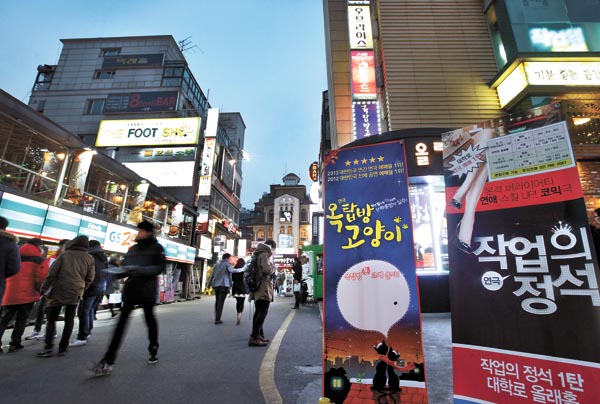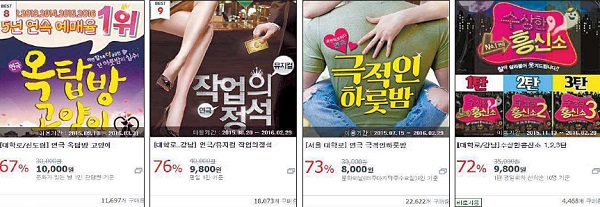Pricing crisis takes toll on Seoul’s theater district

The so-called theater street of Daehangno in central Seoul, known as the cradle of creative Korean plays, is filled with promotional posters and signs that try to attract young Koreans to the latest productions. [PARK SANG-MOON]
The play features four actors - two males and two females - who were staging the play with great enthusiasm, glowing with sweat. Although the plot and direction were a bit sloppy, the audience applauded ardently, perhaps for the actors’ passionate performance. It was quite a large audience, given that the play’s open-ended run began four years ago. But when the curtain finally fell and the audience got up to leave, this reporter couldn’t help but overhear one couple’s conversation.
“It wasn’t that great, right?” a woman said to her boyfriend. “I think the play we saw last time was way better.”
“It’s no surprise,” agreed the boyfriend. “This play only cost 1,000 won [$0.81].”

On the social commerce site Coupang, tickets for many plays staged in Daehangno are being sold at below 10,000 won (8.15 dollars). The original price is around 30,000 won per ticket. [screen capture]
But Jeong Jin-guk, head of the “Love Scam” production company, explained, “The higher the sales volume, the more exposure the play gets on the top of social commerce sites.”
“It’s like biting the bullet, but there’s no other option,” he added.
Another producer for small-scale Korean plays also lamented, saying, “There are many days when there’s not even 10 people sitting in the auditorium on weekdays,” adding that it’s better “to sell them for 1,000 won in dumping sales.”
According to Jung Dae-kyung, chairman of the Federation of Small Theaters, the price collapse over the past few years began with the emergence of social commerce sites.
As of Sunday, there were four plays running in Daehangno for which the tickets are being sold for 1,000 won, whereas the usual price is 30,000 won. But according to industry insiders, someone who pays full purchase price for tickets to a play is known as a “total mug.” Usually, tickets are available online for at least a 70 percent discount, so even those who pay 10,000 won are said to have paid too much. So even though the standard ticket price was 30,000 won, the established price for theatergoers today is about 8,000 won.
Another factor in the trend according to industry insiders is the “1+1” ticket policy that was initiated by the government to support the depressed performing arts industry after the outbreak of Middle East respiratory syndrome last year. Through this initiative, which will come to an end at the end of this month, customers can get a free ticket upon purchase of one theater ticket, which costs 15,000 won online. Thus, one ticket costs only 7,500 won.
In addition to these factors, the direct cause of the price collapse is oversupply. The JoongAng Ilbo looked into theaters in Daehangno for two-and-a-half weeks and found out that as of Sunday, there were 55 plays for which the tickets cost below 10,000 won each.
“You can basically purchase nearly all the open-run play tickets in Daehangno for less than 10,000 won,” said Sohn Sang-won, head of the Korea Performing Arts Producers’ Association.
In the past, there were plays with such cheap tickets known as “backstreet plays.” The plot of the plays or the staging would be quite shoddy, but with their comic elements and cheap tickets they attracted large crowds. This type of performance was not regarded as mainstream, but since 2013 they have slowly become a general trend.
Gradually, this type of production that used to only attract audiences with cheap tickets began to show higher quality direction and staging as well as strong plots, as seen in “Rooftop Room Cat” and “The Art of Seduction.” These shows became megahits with unprecedented attendance rates. As the trend grew, more such plays began to appear, starting a price war among producers.
“Two years ago, 11 producers of Daehangno plays got together and reached a consensus that we maintain a minimum ticket price of not below 12,000 won,” a producer said. “But one producer broke that agreement within a month, and now there’s no business morality whatsoever here.”
The main victims of this phenomenon are the actors who appear in such plays. In general, about four actors appear in these so-called low price plays. They used to be paid about 20,000 won to 50,000 won per appearance, but recently it dropped to as low as 15,000 won per appearance.
“It’s not like we appear because of our dignity as actors,” said one performer from such a play who requested anonymity. “Stories of now-famous actors like Seol Kyung-gu and Song Kang-ho who had once also been poor actors, earning nothing in this theater world, are legends now. It’s a totally different situation now and such cases don’t happen anymore.”
Despite such dire circumstances, many actors still come to audition for these low-price plays, raising the rate of competition for parts to about 20 to 1.
Plays like “The Art of Seduction” and “A Killer Story” get staged four times on weekdays and five times on weekends. Two different plays are even staged in the same theater on the same day. On Feb. 10, the last day of the Lunar New Year holiday, a play titled “Medley of Adolescence” was staged at JeongBo Theater in Daehangno at 3 p.m. When the curtain came down at 4:30 p.m., a different romantic comedy titled “Painful Date” started up 30 minutes later. The stage was exactly the same, and only the props changed.
“During the day we target young students in their teens, while during the evening we aim to attract college students,” said Jo Seong-jong, the producer of the two plays. There are nine more theaters in Daehangno that stage two plays at the same time.
Audiences have mixed responses to these shows, with one half saying they are somewhat satisfied considering the cost-effectiveness, while the other half says, basically, you get what you pay for.
Fewer than five low-price plays actually turn a profit, while the vicious cycle of ticket price collapse, low production cost, low-quality production and finally dissatisfied audiences continuing for most plays.
“Daehangno used to refer to a cradle of creative plays, but that reference is no longer valid,” said Jung from the Federation of Small Theaters.
BY CHOI MIN-WOO [sharon@joongang.co.kr]










with the Korea JoongAng Daily
To write comments, please log in to one of the accounts.
Standards Board Policy (0/250자)